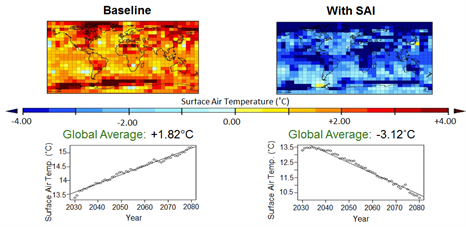Modelling sulphur atmospheric injections from 2030 to 2080
H. Bradford, P. Cheema, R. Dickinson, I. Player, M. Simpson, A. Too
In December 2015 at the Paris climate conference (COP21), 195 countries adopted the first legally binding agreement on climate change, with the ultimate goal to limit global warming to below 2 °C by reducing global CO2 emissions.
However, in order to buy time for effective governmental policies to come into place, there has been ever increasing interest in methods of geoengineered global cooling. One such technique is Sulphur Atmospheric Injection (SAI), which releases sulphur dioxide aerosols into the stratosphere to both reflect incident sunlight directly and indirectly by promoting cloud formation.
This project aimed to model the effects of SAI on the global surface air temperature and precipitation using the Educational Global Climate Modelling (EdGCM) software.
The model used projections of atmospheric CO2 concentration as presented by the representative concentration pathway (RCP) 6 as a control, accounting for intermediate CO2 emission with application of technological strategies to reduce greenhouse gas emission.
This was then compared to the predictions based upon the addition of SAI. Sulphur concentration was not an available parameter in the software package and so solar luminosity was used as an analogue.
Figure 1 - Representative Concentration Pathways

Figure 2 - Predicted Surface Air Temperature for Baseline and SAI
The simulations showed that SAI has the potential to drop global average temperature by 3.12 °C comparative to recent averages and 4.94 °C compared to 2080 predictions. This would mitigate the 2 °C maximum limit imposed by the COP21 and drastically reduce the severe side effects associated with global warming.
There are some key disadvantages to take into consideration with this approach however. Foremost is the environmental impact releasing sulphur into the atmosphere would have on food production and species conservation. Additionally, the effects of SAI could in fact be too potent and global cooling could become a problem.